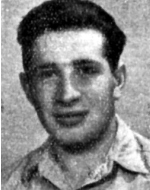Arieh, son of Reizel and Yosef, was born on April 14, 1962, in Warsaw, the capital of Poland. A member of a Hasidic family. He studied in the cheder and was educated in the spirit of tradition and religion. On the eve of World War II, Poland was the focal point of world Jewry in the fields of religious, national, political, social and cultural activity. There were about three and a quarter million Jews living there. The severe economic crisis that gripped the world at the end of the 1930s had a profound effect on Poland’s agriculture, exacerbating anti-Semitic tendencies and repressing the Jews, who were considered to hold a key position in economic life. They suffered from an anti-Jewish economic boycott and growing pogroms. On September 1, 1939, World War II broke out with the German invasion of Poland and its conquest in the lightning war (“Blitzkrieg”). Immediately thereafter, anti-Jewish decrees and regulations were issued that resulted in the social isolation of the Jews, their economic deprivation, and the undermining of all their systems of life. After a short time, the concentration of the Jews began in the ghettos, and later on they were sent to extermination camps. At the end of the war only 300,000 Jews remained in Poland. From his entire family he was the only Aryan who survived the war and the horrors of the Nazis. Was in the death camps of Treblinka and Auschwitz, and was miraculously saved. At the end of the war, in 1945, during his wanderings and attempts to reach Switzerland where he hoped to find his uncle, Nasser Aryeh. He was sent to Paris, where he was promised that he would receive a permit to immigrate to Eretz Israel. On July 16, 1945, Aryeh arrived in Israel and chose to join a religious kibbutz. He was sent to Kibbutz Chafetz Chaim in the Judean Lowland. But Aryeh found it hard to adapt to the cooperative life, and after finding his relatives in Israel, they took him to their home in Tel Aviv and took care of his recovery. In Tel Aviv, Arie joined the Histadrut labor federation. He worked at the Reading power station. Was acceptable to all his colleagues at work and beyond. Loved poetry and was interested in the new songs of the Land of Israel, whose words he copied to his notebook at every opportunity. At the beginning of the War of Independence, Aryeh served in the Haganah, a unit that was meant to protect Jews in the settlements and was organized in areas, sections, and positions, and immediately joined the 12th Battalion of the Golani Brigade. He served in the “Micha” Company as a machine gunner, in which he participated in the conquest and defense of Tiberias, in battles in the Galilee and in the Jordan Valley, and filled all his functions with vigor and enthusiasm. Arab village in the Lower Galilee, near which the agricultural training farm and the settlement of Ilaniya were established at the end of the nineteenth century – an important station in the history of the labor movement, guard and defense. And the hills surrounding it were located near an important ancient junction (now the Golani Junction), which dominated the road between Afula and Tiberias and held it very important for control of the Lower Galilee.At the end of the first truce in the War of Independence, Which was established in the Galilee and constituted a threat to all the northern communities, and to remove the fear that its strongholds would be used as positions of the Syrian and Lebanese armies. “The fighting began on July 9, 1948, when Golani “Attacked the area of the intersection and captured an outpost in the area. But the next day the Arabs responded with a counterattack against Gaza and managed to reach the gates of the settlement of Ilaniya. The “Salvation Army” was accompanied by artillery shells and irregular forces from the Arab villages in the area, and the fighting lasted for eight consecutive days, when the guards on the hills around Sejera passed from hand to hand. During the fighting dozens of Israeli fighters fell. When the battles ended, the junction remained in the hands of the IDF, and the “rescue army” suffered a severe blowIlaniya’s tea prevented the disintegration of the Jezreel Valley and the disconnection of the Galilee. During the operation Nazareth was conquered, where Kaukji’s headquarters was located, the Lower Galilee was liberated and part of the State of Israel. In the battle of Sejera, on the 12th of Tammuz 5708 (July 12, 1948), Aryeh was killed at the age of twenty-five, and Aryeh was buried in Kfar Tavor Two years later, on the 19th of Tammuz, 22.6.1950, In the Nahalat Yitzhak military cemetery. This hero is a “last scion”. The survivors of the Holocaust are survivors of the Holocaust who survived the last remnant of their nuclear family (parents, brothers, sisters, sons and daughters) who experienced the Holocaust in the ghettos and / or concentration camps and / or in hiding and hiding in territories occupied by the Nazis and / Or in combat alongside members of the underground movements or partisans in the Nazi-occupied territories who immigrated to Israel during or after World War II, wore uniforms and fell in the Israeli army.
